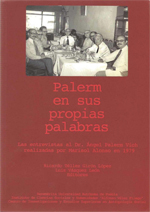Sources
News about publications of primary sources and editorial projects useful for researching about indigenismo.
http://www.oas.org/es/ Ricardo Téllez Girón López, Luis Vázquez León (eds.) Benemérita Universidad Autónoma de Puebla, Instituto de Ciencias Sociales y Humanidades «Alfonso Vélez Pliego», Centro de Investigaciones y Estudios Superiores en Antropología Social, 2013 |
 |
![]() Juan Martín Sánchez «Vivanco Guerra, Alejandro: Una etnografía olvidada de los Andes. El valle del Chancay (Perú) en 1963, Edición crítica de Juan Javier Rivera Andía, Madrid, CSIC, 2012»,
Juan Martín Sánchez «Vivanco Guerra, Alejandro: Una etnografía olvidada de los Andes. El valle del Chancay (Perú) en 1963, Edición crítica de Juan Javier Rivera Andía, Madrid, CSIC, 2012»,
Juan Martín Sánchez «Vivanco Guerra, Alejandro: Una etnografía olvidada de los Andes. El valle del Chancay (Perú) en 1963, Edición crítica de Juan Javier Rivera Andía, Madrid, CSIC, 2012»,
[Enlace a PDF]
![]() Alejandro Vivanco Guerra, Una etnografía olvidada en los Andes. El valle del Chancay (Perú) en 1963,
Alejandro Vivanco Guerra, Una etnografía olvidada en los Andes. El valle del Chancay (Perú) en 1963,
Critical edition by Juan Javier Rivera Andía, Madrid: CSIC, 2012. Book series: De acá y de allá. Fuentes etnográficas
In this volume, Juan Javier Rivera presents an ambitious critical edition of the ethnographic work Justo Alejandro Vivanco Guerra conducted in indigenous communities of the Chancay Valley in the central highlands of Peru. Vivanco was born in 1910 in Huamanga (capital of the department of Ayacucho), where he learned Quechua and started playing regional music. After working as a music teacher, he joined in 1962 the Institute of Ethnology and Archaeology at the University of San Marcos. The same year, the Institute organized an expedition to the upper valley of Chancay, the beginning of the project «Studies of changes in Peruvian communities», supported by Cornell University. Among the six Peruvian universities participating in the project, the University of San Marcos was chosen to study the Chancay Valley. Vivanco participated in the group of students, led by Matos Mar, who was in charge of the investigation, but, in his age (he was fifty-two old), there were more differences than similarities with respect to their fellow students. His great musical education and its proximity to José María Arguedas gave their observations and descriptions an ethnographic perspective; some would call a «folk» one, really special among those made by the group. Vivanco’s work has been almost completely unedited (with the exception of some partial editions by Rivera) and this recent publication has a twofold importance: that of exposing these valuable materials and offering an interesting contrast with the works of the «social» anthropology that dominated the discipline in Peru in the sixties and seventies.
![]() For more information about CDI’s editorial projects, see this text by Margarita Sosa Suárez, director of the CDI archives
For more information about CDI’s editorial projects, see this text by Margarita Sosa Suárez, director of the CDI archives
[link to pdf]
![]() Book series «Pioneros del indigenismo en México»
Book series «Pioneros del indigenismo en México»
The Mexican National Commission for Indigenous Peoples Development (Comisión Nacional para el Desarrollo de los Pueblos Indígenas or CDI) started in 2009 the publication of the book series «Pioneros del Indigenismo en México», a number of ethnographical and anthropological works written in 1950s and 1960s, available at the historical archives of the Nation Indigenist Institute (Instituto Nacional Indigenista or INI) and never published previously.
Títulos publicados hasta ahora:These volumes have already been published:
- Monopolio de aguardiente y alcoholismo en los Altos de Chiapas. Un estudio incómodo de Julio de la Fuente 1954-1955.
- Fuentes para la historia del indigenismo en México. Diarios de campo de Maurilio Muñoz en el Papaloapan 1956-1959.
- Mixtecos de la costa. Estudio etnográfico de Alfonso Fabila en Jamiltepec, Oaxaca, 1956.
- Las Mixtecas y la región Triqui de Oaxaca. Informe Etnográfico de Pablo Velázquez Gallardo (1954).
- Los yaquis de Sonora. Restitución de tierras, paz y trabajo. Informe etnográfico de Alfonso Fabila (1958).
- Sierra Tarahumara. Estudio etnográfico de Francisco Plancarte (1953-1957). Introducción de Juan Luis Sariego (ENAH Chihuahua).
